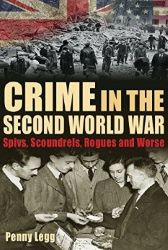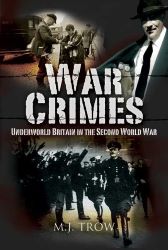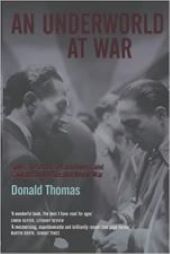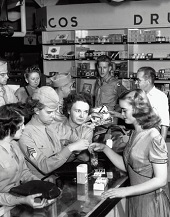How will these resources help you?
The Home Front during World War II is a familiar topic at Key Stage 3. We teach it through the lens of a nation struggling to maintain some sort of normality in incredibly difficult circumstances. They ‘Dig for Victory' and they ‘Make Do and Mend’. In Anderson shelters, they read bedtime stories to their children, unless their children have been sent away as evacuees to live with strangers for safety. Men join the Home Guard and women the Land Army. People deal with the blackout, bombing and rationing.
All this is well-trodden ground and we use plenty of primary-source material to enliven and enrich our lessons. However, there is an underside to the Home Front upon which we rarely, if ever, touch. What about the black market, the 'spivs', the looters and the profiteers? It’s not that we are ignorant to their existence, nor that it is all unsuitable for this age group. It’s not even that there is a lack of age-suitable resources. Rather, there seems to be an unspoken reluctance to prick the patriotic bubble, to cast doubt on the image of the whole nation pulling together as one. This could be one of the received myths we encourage our students to question. I would suggest that, for this age group, the black market would be a good introduction to the darker side of the Home Front, and would tie in with the work they will do on rationing. As well as the resources below, local newspaper archives may prove fruitful for the topic.
All this is well-trodden ground and we use plenty of primary-source material to enliven and enrich our lessons. However, there is an underside to the Home Front upon which we rarely, if ever, touch. What about the black market, the 'spivs', the looters and the profiteers? It’s not that we are ignorant to their existence, nor that it is all unsuitable for this age group. It’s not even that there is a lack of age-suitable resources. Rather, there seems to be an unspoken reluctance to prick the patriotic bubble, to cast doubt on the image of the whole nation pulling together as one. This could be one of the received myths we encourage our students to question. I would suggest that, for this age group, the black market would be a good introduction to the darker side of the Home Front, and would tie in with the work they will do on rationing. As well as the resources below, local newspaper archives may prove fruitful for the topic.
A concise introduction

Crime in the Second World War: Spivs, Scoundrels, Rogues and Worse
by Penny Legg, published by Sabrestorm, (2017), 9781781220092
Legg provides a useful and very readable introduction to the subject. Chapter 2, The Black Market, makes a good starting point as it deals effectively with rationing and then moves on to describe the opportunities this provided for black marketeers, and the attitude of authorities to the black market. There are pen-portraits of black marketeers and the whole concept is well illustrated.
Contextualising the crime

War Crimes: Underworld Britain in the Second World War
by M. J. Trow, published by Pen and Sword Books, (2008), 9781844157280
This book informatively contextualises the black market as one of the most prolific crimes of the wartime era, akin in public perception to smuggling in the 18th century. It deals with a range of crimes for which the war provided an unrivalled opportunity, including the black market. Chapter 4 deals specifically with the black market, neatly followed by the impact that the arrival of American servicemen had on crime in general and on the provision of food for the black market in particular.
Comprehensive coverage

An Underworld at War: Spivs, Deserters, Racketeers and Civilians in the Second World War
by Donald Thomas, published by John Murray Press, (2004), 9780719563409
This excellent, detailed book ably explores every aspect of the 1940s underworld. Lively and interesting, Chapter 7, Under the Counter, includes anecdotes that really bring the topic to life. For example, Thomas illustrates the bitterness of the mayor of Stepney towards profiteers, and tells the story of the Liverpool butcher imprisoned for masterminding a major meat racket.
Audiovisual clips

Blitz: The Bombs That Changed Britain - Self help during the Blitz
published by BBC, (2017)
Bombings and general warfare forced people to come up with alternative ways to survive, like seeking shelter in tube stations or buying sustainance items from the black market.
Quiz - student's copy
Test your students' knowledge with these questions on the above clip.
Includes a Vocabulary section.
Includes a Vocabulary section.
Quiz - teacher's copy
Test your students' knowledge with these questions on the above clip (with answer key).
Includes a Vocabulary section.
Includes a Vocabulary section.
Further Materials
Wartime: Britain 1939–1945 by Juliet Gardiner, published by Headline, (2016), 9781472241498
Find this book
The Home Front by Arthur Marwick, published by Thames and Hudson, (1978), 9780500271148
Find this book
Rosemary Rees is an experienced teacher of history to students in the secondary, further and higher sectors of education. She has worked as an examination-board administrator and a chief examiner, and served as a governor of a primary school and chair of governors of a comprehensive school. She now spends her time writing and editing text books for Key Stages 3, 4 and 5.
Text © Rosemary Rees, 2020.
Text © Rosemary Rees, 2020.



